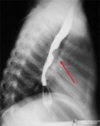SM 166a - Congenital and Pediatric Disorders Flashcards
(51 cards)
You suspect an airway abnormality in your 3 month old patient. You can hear stridor when they breathe, and bronchoscopy reveals an omega-shaped epiglottis.
What is the most likely diagnosis?
How is it treated?
Laryngomalacia
Evaluate for aspiration and reflux, treat if necessary
The laryngomalacia may resolve on its own, surgery may be necessary if severe
What defines bronchopulmonary dysplasia?
How is severity defined?
Continued airway and parenchymal abnormalities in an infant with RDS.
Severity is defined by the amount of supplemental oxygen required at:
36 week post-menstrual age (if the baby was born at <32 weeks gestational age)
OR
56 DOL if (if the baby was born ≥32 weeks gestational age)
-
Mild
- Breathing room air
-
Moderate
- Breathing <30% FiO2
-
Severe
- Breathing >30% FiO2 or requiring positive pressure ventilation
At what stage of embryonic development do alveolar cells differentiate into type 1 and type 2?
Saccular stage (24-36 weeks/birth)
What causes laryngomalacia?
Floppiness/softening of the larynx
Any of the following are possible:
- Omega-shaped epiglottis
- Short aryepiglottic folds
- Prolapsed arytenoids
What abnormality is shown in this image?

Vascular sling: aberrant left pulmonary artery
The arrow is pointing to the left artery that is sneaking between the esophagus and the trachea

How is a vascular ring or sling diagnosed?
Barium swallow
Will show compression of the esophagus or bronchial tree
What congenital lung malformation is shown in this x-ray of a 2-month old girl?

Congenital pumonary aiway malformation (CPAM)
The arrow is pointing to a large systic mass

What congenital lung malformation is shown in these pictures?

Tracheo-Bronchomalacia

What are the risk factors for bronchopulmonary dysplasia?
- Low birth weight
- Low gestational age
- Infections (maternal and infant)
- Positive pressure ventilation
- O2 toxicity
What is the treatment for laryngomalacia?
Evaluate for aspiration and reflux, treat if necessary
The laryngomalacia may resolve on its own, surgery may be necessary if severe
What is a bronchopulmonary foregut malformation?
Abnormal lung tissue is connected to the GI tract
What are ongenital pulmonary airway malformations?
A heterogeneous group of congenital cystic and non-cystic lung masses characterized by extensivve overgrowth of the primary bronchioles in communication with the abnormal (lacks cartilage) bronchial tree
Why are mothers at risk for preterm delivery prescribed steroids prior to 34 weeks?
To decrease the infant’s risk of bronchopulmonary dysplasia
What is congenital lobular emphysema?
Overinflation or distension of one or more pulmonary lobes
May have intrinsic or extrinsic causes
What congenital lung malformation is shown in this CT scan of a 2-month old girl?

Congenital pumonary aiway malformation (CPAM)
The arrow is pointing to a large systic mass

What is an intralobular pulmonary sequestration?
Extra lung tissue si sompletely covered by normal lung tissue OR by a segment of visceral pleura of the associated lung lobe
May be congenital or acquired
What is respiratory distress syndrome (RDS) in newborns?
A newborn has RDS if their lungs do not have enough surfactant
- Often seen in premature infants
- Surface tension increases
- Compliance decreases
- Breathing requires more effort
Describe the clinical presentation of a pumonary AVM
Asymptomatic hypoxia
OR
Bleeding in the lungs (pumonary hemorrhage, hemoptysis
List 3 congenital airway abnormalities
Laryngomalacia
Tracheo-bronchomalacia
Tracheoesophagel fistula (TEF)
How is a pumonary AVM diagnosed?
chest x-ray or angiography
How is a pulmonary AVM treated?
Embolization if it is large enough; the vessel is occluded so blood does not enter the AVM
What is the treatment for tracheo-bronchomalacia?
Surgery if severe
List the 3 major types of pulmonary sequestration
- Intralobular pulmonary sequestration (most common)
- Extralobular pulmonary sequestration
- Bronchopulmonary foregut malformation
What are the etiologies of intralobular pulmonary sequestration?
-
Congenital
- Sequestration arises from the lung bud during development
-
Acquired
-
Sequestration develops after bronchial obstruction
- ex: pneumonia -> no perfusion if no ventilation -> parasitation of pulmonary arteries
-
Sequestration develops after bronchial obstruction




















